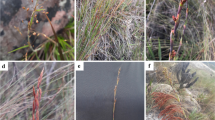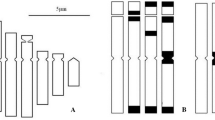Abstract
Meiotic pairing inTradescantia soconuscana 2n=26 (6M+16A+4T) suggests that it has a tetraploid constitution which is not apparent in its chromosome number. Its “nombre fondamental” of 32 indicates that it could have evolved from an ancestor with x=8 by a combination of Robertsonian fusion, hybridization and polyploidy. The 2n=16 (8A+8T) karyotype of a closely related diploid supports this. The allied genusZebrina may have followed a similar method of chromosome evolution.
Similar content being viewed by others

References
Bowen, C. C., 1956: Freezing by liquid carbon dioxide in making slides permanent. — Stain Technol.31: 87–90.
Darlington, C. D., 1929: Chromosome behaviour and structural hybridity in theTradescantiae. — J. Genet.21: 207–286.
Holmquist, G., Dancis, B. M., 1980: A general model of karyotype evolution. — Genetica52/53: 151–163.
Hunt, D., 1975: The reunion ofSetcreasea andSeparotheca withTradescantia. AmericanCommelinaceae 1. — Kew Bull.30: 443–458.
—, 1980: Sections and series inTradescantia. AmericanCommelinaceae 9. — Kew Bull.35: 437–442.
—, 1986:Campelia, Rhoeo andZebrina united withTradescantia. AmericanCommelinaceae 13. — Kew Bull.41: 401–405.
John, B., Freeman, M., 1975: Causes and consequences of Robertsonian exchange. — Chromosoma (Berlin)52: 123–136.
Jones, K., 1978: Aspects of chromosome evolution in higher plants. — Adv. Bot. Res.6: 119–194. — London: Academic Press.
—, 1984: Mechanisms of chromosome change in the tribeTradescantieae (Commelinaceae). — InSharma, A. K., Sharma, A., (Eds.): Chromosomes in evolution of eukaryotic groups 2, pp. 143–168. — Boca Raton, FL: CRC Press.
—, —, —, 1981: Contributions to the cytotaxonomy of theCommelinaceae. Chromosome evolution inTradescantia sectionCymbispatha. — Bot. J. Linn. Soc.83: 157–188.
Kenton, A., 1981: Chromosome evolution in theGibasis linearis alliance (Commelinaceae). — Chromosoma (Berlin)84: 291–304.
—, 1984: Robertsonian differentiation and preferential pairing revealed in species and F1 hybrids in theGibasis linearis group (Commelinacae). — Pl. Syst. Evol.144: 221–240.
Mattsson, O., 1971: Cytological observations within the genusZebrina. — Bot. Tidsskr.66: 189–227.
Author information
Authors and Affiliations
Rights and permissions
About this article
Cite this article
Jones, K. Robertsonian change in allies ofZebrina (Commelinaceae). Pl Syst Evol 172, 263–271 (1990). https://doi.org/10.1007/BF00937811
Received:
Accepted:
Issue Date:
DOI: https://doi.org/10.1007/BF00937811



